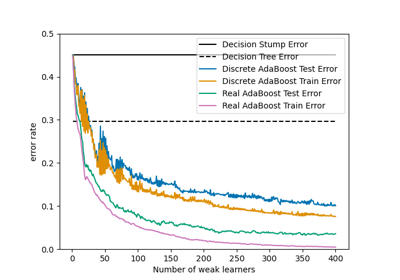sklearn.metrics.zero_one_loss¶
- sklearn.metrics.zero_one_loss(y_true, y_pred, *, normalize=True, sample_weight=None)[source]¶
Zero-one classification loss.
If normalize is
True, return the fraction of misclassifications (float), else it returns the number of misclassifications (int). The best performance is 0.Read more in the User Guide.
- Parameters:
- y_true1d array-like, or label indicator array / sparse matrix
Ground truth (correct) labels.
- y_pred1d array-like, or label indicator array / sparse matrix
Predicted labels, as returned by a classifier.
- normalizebool, default=True
If
False, return the number of misclassifications. Otherwise, return the fraction of misclassifications.- sample_weightarray-like of shape (n_samples,), default=None
Sample weights.
- Returns:
- lossfloat or int,
If
normalize == True, return the fraction of misclassifications (float), else it returns the number of misclassifications (int).
See also
accuracy_scoreCompute the accuracy score. By default, the function will return the fraction of correct predictions divided by the total number of predictions.
hamming_lossCompute the average Hamming loss or Hamming distance between two sets of samples.
jaccard_scoreCompute the Jaccard similarity coefficient score.
Notes
In multilabel classification, the zero_one_loss function corresponds to the subset zero-one loss: for each sample, the entire set of labels must be correctly predicted, otherwise the loss for that sample is equal to one.
Examples
>>> from sklearn.metrics import zero_one_loss >>> y_pred = [1, 2, 3, 4] >>> y_true = [2, 2, 3, 4] >>> zero_one_loss(y_true, y_pred) 0.25 >>> zero_one_loss(y_true, y_pred, normalize=False) 1
In the multilabel case with binary label indicators:
>>> import numpy as np >>> zero_one_loss(np.array([[0, 1], [1, 1]]), np.ones((2, 2))) 0.5

